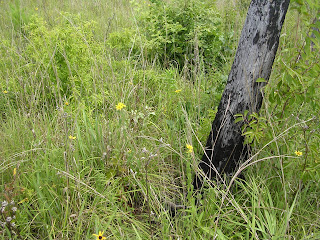Last Saturday, June 16th, I visited Harrell Prairie with some people from the Mississippi Native Plant Society. Heather Sullivan, staff botanist at The Mississippi Museum of Natural Science led the group. We saw a lot of purple coneflower and yellow prairie coneflower (Ratibida). We spent a lot of time looking for a blooming eryngium yuccifolium, rattlesnake master. We found lots of individual plants, but none in bloom. Other plants seen include butterfly milkweed, mountain mint, and asters.
Ceanothus americanus New Jersey Tea
A native Lythrum, or loosestrife. This is not the invasive purple loosestrife.
Helianthus, scrubby oaks, burned oak.
This huckleberry is common at Harrell Prairie. The others said is was good to eat and lamented that it is not yet ripe.
This aster was spotted several times.
One of the few blooming Rattlesnake Master plants. All in all we were on the prairie for a little over two hours with a group of about thirty people, all ages. Temperatures rose into the low nineties and most of the group decided to call it a day. But a few hard-core prairie enthusiasts, including my friend from the MSU Landscape Architecture graduate program Rob Anders, southern gardener and "certifiable plant fool" Gail Barton, and an avid gardener from Vicksburg named Jennifer, decided to tour some of the recently restored prairie remnants in the Bienville National Forest. Here is a large one on Morton-Marathon Road:
At this prairie we were serenaded by some large and noisy hawks overhead. We were impressed with how intact and diverse this patch is. In the very midst of it, Gail flushed a turkey. She had been sitting on nine eggs in the shade of a small persimmon tree. We spent a good long hour here, then walked around another large patch on Walk Hill Road. We told stories related to our experiences in the green industry, landscaping, gardening and botanizing. It was a great day.













I've been thinking about this trip all week. I learned several new plants and had a great time.
ReplyDelete